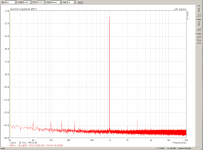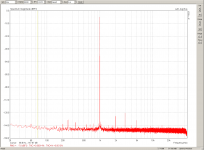@Richidoo: Thank you very very very much for your long answer.
My little KEF Q100 (86dB at 8 ohm) with AV Marantz SR4500 (105W at 0.1% THD and 105 db S/N) does not have problems with orchestral mass.
Maybe I need some Parallel 86 in bridge.
By the way, I have some very good vinyl rips with Dynamic Range (DR) 17!
My little KEF Q100 (86dB at 8 ohm) with AV Marantz SR4500 (105W at 0.1% THD and 105 db S/N) does not have problems with orchestral mass.
Maybe I need some Parallel 86 in bridge.
By the way, I have some very good vinyl rips with Dynamic Range (DR) 17!
Tom
could you expand on "pretty decent soldering skills". I've done a certain amount of soldering but I don't think I would say I'm good at it. (Although the more I do the better I get.) For example, if I was to go for the Fremen I would ask Dario to solder the smd parts, which he will do for a modest charge. Is any of the soldering particularly difficult?
could you expand on "pretty decent soldering skills". I've done a certain amount of soldering but I don't think I would say I'm good at it. (Although the more I do the better I get.) For example, if I was to go for the Fremen I would ask Dario to solder the smd parts, which he will do for a modest charge. Is any of the soldering particularly difficult?
Fred, no offense taken. Audio bulletin board users must develop thick skin, along with other skills.
Tom, you are the consummate professional, and I'm sure you offer a fine product. Glad to see you contributing here and elsewhere.
I really like some of the features of the Mod86, and I admire the way it meets the designer's goals. I really like the way the MyRef sounds (it does not add distortion or roll off the highs; it simply does not sound like a SS amp), and I have seen it posted here that it also measures better than many commercial offerings. It might not have as many zeroes as the Mod86, but can anyone really hear the difference between .004 and .008 or whatever? Of course not. At some point, mere zeroes do NOT tell the whole story.
Pity that all the hot air here has still not addressed the original question: has anyone heard both? Some good points have been made, even by some of you gasbags who have heard neither. Wish I could hear the Mod86 and offer an informed opinion, but then it would be just another useless subjective impression. If all one has is a pair of ears and not a lab full of measuring gear to detect how many zeroes follow the decimal point, one's opinion means nothing. Ridiculous.
If you want balanced/SE inputs, Mod86. If you want vanishingly low measured distortion and noise, Mod86, with MyRef an inaudibly close second. If you want through-hole simplicity, Mod86. If you want economy and newer SMD technology, MyRef. If you want build-and-play consistency, Mod86. If you want to tinker and tailor the tone of the amplifier sound to your liking, MyRef. If you want on/off/failure speaker protection via relay, not just what is provided by the LM3886, MyRef. If you want an amp designed by a talented professional design engineer with access to reference testing equipment (who also has a modest commercial interest and provides thorough technical support), Mod86. If you want one designed by a very clever person with more than a little technical knowledge and an obsession with making the best sounding chip amp (who then bestowed the design to the DIY community and was practically chased away by "smart" people), which is supported and has been refined by a large population of dedicated builders, MyRef. Carry on from here...
Peace,
Tom E
Thank you Tom. I may end up being the first person to build both!
As someone mentioned already, the LM3886 does have some protection built in for over-current and over-heating. There is no protection circuit to protect your speaker if the LM3886 blows. The LM3886 is pretty darn rugged, so I doubt you'll be able to blow one, but it could happen. Many amps work just fine without the protection circuitry.
Designing a protection circuit is a challenge in its own right. It needs to actually provide protection - i.e. work fast in the event of a catastrophic failure. It also needs to be sonically transparent (not add to the THD). It should not trigger on false errors. That's a pretty tall order, actually.
I run my amps without protection. I sleep well at night...
Tom
Thank you for your answer.
Been sleeping well for 40 years
Although when bought new 'then' my speakers were affordable.. currently their replacements are in the Tens of Thousands.
Moderne Times indeed.
Does give some pause though, no denying that.
Merely curious , as it seems a current 'must have' for many.
Needed or not.
Echoing your thoughts albeit with none of your knowledge: I also thought that a 'Decent' protection circuit
could be a significant gizmo indeed.. a Bit more involved than some 10$ ebay lashup.
*Esperado* has/offers a sophisticated design..a Surprisingly complex thing.
Tom
could you expand on "pretty decent soldering skills". I've done a certain amount of soldering but I don't think I would say I'm good at it. (Although the more I do the better I get.) For example, if I was to go for the Fremen I would ask Dario to solder the smd parts, which he will do for a modest charge. Is any of the soldering particularly difficult?
The MOD86 and PAR86 use leaded components. As does the THAT Driver, by the way. I do that to make the soldering as easy as possible for the folks with less soldering experience. I also use oversized pads for the components to prevent the pads from lifting if the builder applies a bit too much heat. This again to make it easier for the relative beginner. Some of my boards have also been up-reved to x.01 for ease of soldering. In the MOD86 R1.0 -> 1.01 update, I shifted two resistors and two diodes by 1-2 mm to make the board easier to solder. I was able to do this without sacrificing electrical performance. In summary: In addition to optimizing for electrical performance, I put a fair amount of thought into ease of assembly (both soldering and mechanically).
If you've assembled a kit with leaded components you'll likely do fine. You need to be able to identify the anode and cathode of a diode, pin 1 on a DIP packaged IC, and the flat on a TO-92 package. You need to be able to make a solder joint that connects the component to the board reliably. Having a solder sucker or de-soldering braid (solder wick) handy to clean up any messes is recommended.
As Bill said. It's pretty easy. The LM3886 is the tricky one as you need to make sure it's perpendicular to the board. There are any number of ways to accomplish this. I usually use the chassis and heat sink as a jig.
Tom
Although when bought new 'then' my speakers were affordable.. currently their replacements are in the Tens of Thousands.
Moderne Times indeed.
Does give some pause though, no denying that.
Um, yeah...
Merely curious , as it seems a current 'must have' for many.
Needed or not.
Echoing your thoughts albeit with none of your knowledge: I also thought that a 'Decent' protection circuit
could be a significant gizmo indeed.. a Bit more involved than some 10$ ebay lashup.
There clearly is a market need. I don't know how big it is, but I do know of ways to find out...
Tom
Yes, the connection of the LM3886 to the heatsink was the tricky part.
This is not just about soldering, that is simple. It is the mechanical alignment of the 3886 with heatsink and enclosure floor that is the tricky bit.
I used a drill and tapped a nice hole in the heatsink. Can't remember if it was blind or through hole... Aluminum heatsinks like kerosene as the cutting fluid. Just dip the tap into the kerosene. A small amount will last your lifetime.
This was my first chip amp, and I did not attach the 3886 to the heatsink before soldering. This was a mistake, since the chip would not sit flat against the heatsink. It needs to be flat to transfer heat..... This job was made simpler on later boards, because the board was narrowed by a couple of mm.
Luckily, the fix was to file the PCB a bit narrower.... there was enough material there so that I would not run into a trace and make a short.
If I was to build a second one, I would first attach the chip to the heatsink, attach the standoffs on the board, put the heatsink and board in place in the enclosure, then tack the LM3886 with a blob or two of solder on the top of the PCB. It will then not move when you take it out to complete the soldering job from the bottom of the PCB, and you will have guaranteed good mechanical coupling between the heatsink and 3886.
It is a terrific little amp. I cannot say enough good things about it.
The other detail you may get stuck on in a project is the grounding scheme -- some kits do not specify one. This project does, and Tom helped when I had some questions about how his grounding scheme fit with what I knew about grounding... admittedly, just enough to be wrong!
If you follow the build directions, you will not go wrong.
This is not just about soldering, that is simple. It is the mechanical alignment of the 3886 with heatsink and enclosure floor that is the tricky bit.
I used a drill and tapped a nice hole in the heatsink. Can't remember if it was blind or through hole... Aluminum heatsinks like kerosene as the cutting fluid. Just dip the tap into the kerosene. A small amount will last your lifetime.
This was my first chip amp, and I did not attach the 3886 to the heatsink before soldering. This was a mistake, since the chip would not sit flat against the heatsink. It needs to be flat to transfer heat..... This job was made simpler on later boards, because the board was narrowed by a couple of mm.
Luckily, the fix was to file the PCB a bit narrower.... there was enough material there so that I would not run into a trace and make a short.
If I was to build a second one, I would first attach the chip to the heatsink, attach the standoffs on the board, put the heatsink and board in place in the enclosure, then tack the LM3886 with a blob or two of solder on the top of the PCB. It will then not move when you take it out to complete the soldering job from the bottom of the PCB, and you will have guaranteed good mechanical coupling between the heatsink and 3886.
It is a terrific little amp. I cannot say enough good things about it.
The other detail you may get stuck on in a project is the grounding scheme -- some kits do not specify one. This project does, and Tom helped when I had some questions about how his grounding scheme fit with what I knew about grounding... admittedly, just enough to be wrong!
If you follow the build directions, you will not go wrong.
It's difficult to make a kit not work simply because of through-hole soldering. The solder magically does most of the work. I've seen pics here of some atrocious soldering jobs, and the amps still worked. I would venture that a hot iron and clean tip are more important than the person soldering. Go in hot, get out fast. Plenty of good tutorials on youtube. It's a basic learned skill, but you need good tools and materials.
A better solder joint, or rather, 50 better solder joints will probably sound a little better and certainly be more reliable.
SMD is another story. It's not difficult to misalign one of those tiny parts or gob too much solder, but it can always be cleaned and redone. Ask me how I know. With just a little experience, though, even that gets a lot easier. If more than a hundred other inexperienced builders, some with old eyes and not so steady hands, have done it, you probably can.
Based on his description, Tom's kits are well thought-out and seem pretty easy to build. Maybe you should start with his, then move on to the MyRef. If you were clever about it, you could probably build a single enclosure and just swap amp PCB's! We would all like to learn your impressions.
Peace,
Tom E
A better solder joint, or rather, 50 better solder joints will probably sound a little better and certainly be more reliable.
SMD is another story. It's not difficult to misalign one of those tiny parts or gob too much solder, but it can always be cleaned and redone. Ask me how I know. With just a little experience, though, even that gets a lot easier. If more than a hundred other inexperienced builders, some with old eyes and not so steady hands, have done it, you probably can.
Based on his description, Tom's kits are well thought-out and seem pretty easy to build. Maybe you should start with his, then move on to the MyRef. If you were clever about it, you could probably build a single enclosure and just swap amp PCB's! We would all like to learn your impressions.
Peace,
Tom E
This is all helpful stuff guys, I thank you. The designer of the DAC I will be using to directly drive the amp strongly recommends balanced connections and the rest of my system connections will indeed be balanced. So that's another reason why I've pretty much decided to go Modulus.
maty,
You may want to read this thread, and try Pano's test to determine how much power you actually need. That should give you some objective basis to decide whether the M86 / MyRef will meet your needs.
http://www.diyaudio.com/forums/multi-way/204857-test-how-much-voltage-power-do-your-speakers-need.html
Bill
You may want to read this thread, and try Pano's test to determine how much power you actually need. That should give you some objective basis to decide whether the M86 / MyRef will meet your needs.
http://www.diyaudio.com/forums/multi-way/204857-test-how-much-voltage-power-do-your-speakers-need.html
Bill
@Richidoo: Thank you very very very much for your long answer.
My little KEF Q100 (86dB at 8 ohm) with AV Marantz SR4500 (105W at 0.1% THD and 105 db S/N) does not have problems with orchestral mass.
Maybe I need some Parallel 86 in bridge.
By the way, I have some very good vinyl rips with Dynamic Range (DR) 17!
@lousymusician: Thank you.
I think I do need any bridge. Why?
KEF Q100 has a 4.7 Ohms minimum. I can estimate it has 6 Ohms.
Suppose that the sonnometer measures 3 dB less. 95 dB (2m, front) + 3 dB = 98 dB.
Suppose that the sonnometer measures 3 dB more. 95 dB (2m, front) - 3 dB = 92 dB.
-> Pro-Audio and lighting Calculators. Calculator page
Parallel-86 and Akitika GT-101 can offers more than 70W at 6 Ohms.
86 dB, 70W, 2 speakers in phase, 3 m => 100.9 dB
I think I do need any bridge. Why?
KEF Q100 has a 4.7 Ohms minimum. I can estimate it has 6 Ohms.
Suppose that the sonnometer measures 3 dB less. 95 dB (2m, front) + 3 dB = 98 dB.
Suppose that the sonnometer measures 3 dB more. 95 dB (2m, front) - 3 dB = 92 dB.
-> Pro-Audio and lighting Calculators. Calculator page
Parallel-86 and Akitika GT-101 can offers more than 70W at 6 Ohms.
86 dB, 70W, 2 speakers in phase, 3 m => 100.9 dB
Last edited:
I never had the opportunity to listen to excellent Tom's work but I'm pretty confident it is a brilliant performer.
Just to make it clear... the My_Ref it's not my work, it has been designed by Mauro Penasa, which, like Tom, is a competent engineer.
What I've done is designing a new PCB following the goals Mauro set for it's closed source evolution of the My_Ref, the My_Evo.
That PCB includes a simple but effective new power supply and uses tecniques for HF design and it was my first attempt to design a PCB.
Results were way over my imagination (and competence), as KSTR measurements show:
Just to make it clear... the My_Ref it's not my work, it has been designed by Mauro Penasa, which, like Tom, is a competent engineer.
What I've done is designing a new PCB following the goals Mauro set for it's closed source evolution of the My_Ref, the My_Evo.
That PCB includes a simple but effective new power supply and uses tecniques for HF design and it was my first attempt to design a PCB.
Results were way over my imagination (and competence), as KSTR measurements show:
Hi guys,
I was able to do some measurements of the (shielded and grounded) FE proto on the AP rig.
Rload was 3.67R, Supply 18Vac toroid (+-24V rails), standard bridges, 4700uF. Speaker return at PGND (relay unused).
20R source resistance, no input cap (C13), floating drive (no leakage currents through R11).
A teaser here :
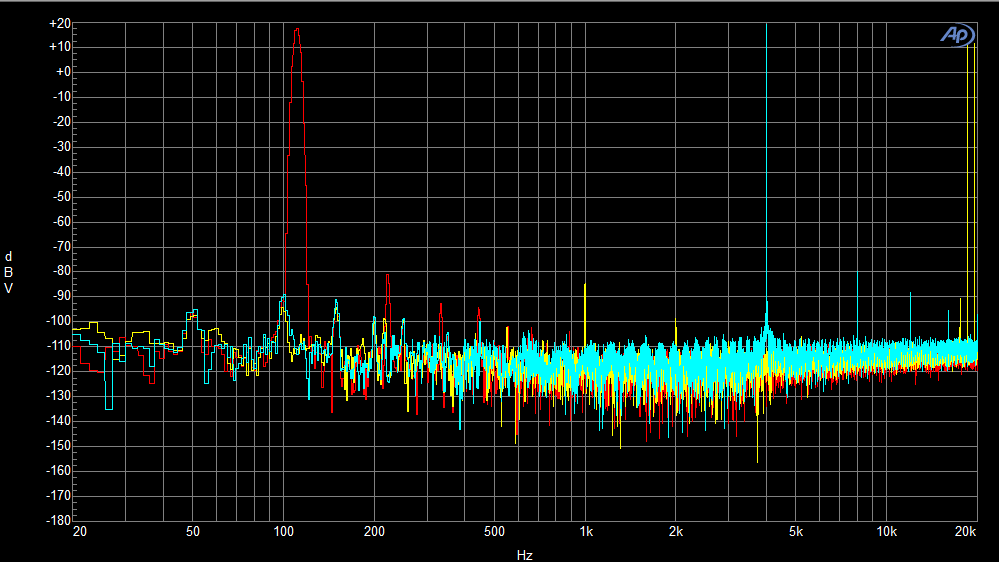
Red : 111Hz @250mVrms input (8Vrms/17W out)
Cyan : 4kHz @300mVrms input (9.6Vrms/25W out -- close to the maximum with the supplies I used)
Yellow : IMD 18.5kHz+19.5kHz (150mVin each)
Harmonic distortion is around -100dB (0.001%) with a nice monotonic decrease of higher orders.
At lower levels the HD quickly vanished in the noise floor.
IMD is better than -90dB.
Hum/buzz components with these signals are 110dB down (and effectively non-visible with no input signal).
A very respectable performance !
Here's the Modulus-86 Rev. 2.0 for comparison. Here's the FFT directly from the APx525 (click on the image for larger view):
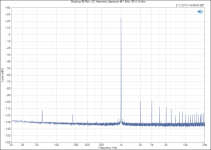
The THD works out to 0.00012 % (38 W, 8 Ω).
At more normal listening levels (1 W), it was necessary to use a precision oscillator (I used Victor's 1 kHz version) to measure the THD. As shown in the plot below, the THD of the Modulus-86 is vanishingly low - 0.000067 % (1 W, 8 Ω).
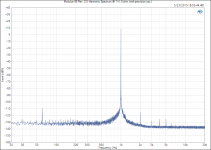
More importantly for sound quality (my subjective experience), the THD+N is nearly flat versus frequency. In my subjective experience, flat THD+N will result in an open and natural sound. The plot below shows the THD+N for 38 W, 8 Ω.
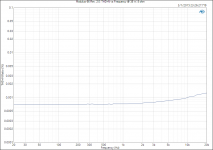
It gets even flatter at 1 W output power:
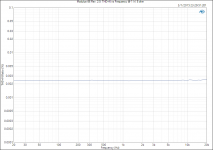
You can find more measurements and specifications on my Modulus-86 Rev. 2.0 page.
Tom

The THD works out to 0.00012 % (38 W, 8 Ω).
At more normal listening levels (1 W), it was necessary to use a precision oscillator (I used Victor's 1 kHz version) to measure the THD. As shown in the plot below, the THD of the Modulus-86 is vanishingly low - 0.000067 % (1 W, 8 Ω).

More importantly for sound quality (my subjective experience), the THD+N is nearly flat versus frequency. In my subjective experience, flat THD+N will result in an open and natural sound. The plot below shows the THD+N for 38 W, 8 Ω.

It gets even flatter at 1 W output power:

You can find more measurements and specifications on my Modulus-86 Rev. 2.0 page.
Tom
Last edited:
Just so as to jump in this stupid game of numbers..
I have shown only recently the measured distortion values of Mauro's MyEvolution amplifier. Which is an expandable design to "two barrels" much like the power 86, is equipped by a proper dc-servo, and exhibits very very good Measured. Low. Distortion. values, which I would like to report also here, just to make some counter-balance to Tom's 'data'.
As it is shown in the Arta spectra, distortion is
0.00012% at 1kHz/1W/7ohm,
0.00014% at 1kHz/14W/7ohm,
and
0.00022% at 1kHz/25W/7ohm
All these values are including the self-distortion of the measurement setup itself, so all of them are to be jugded like 'better than'.
Indeed I had to fight to keep the signal constantly in the sweet spot zone of the card itself, because the contribution of the amplifier is so low.
The original post with measurements is here:
http://www.diyaudio.com/forums/chip...on-build-thread-tutorial-216.html#post4407354
You can find more graphs there, which show the very notable behaviour also at high frequencies.
I have shown only recently the measured distortion values of Mauro's MyEvolution amplifier. Which is an expandable design to "two barrels" much like the power 86, is equipped by a proper dc-servo, and exhibits very very good Measured. Low. Distortion. values, which I would like to report also here, just to make some counter-balance to Tom's 'data'.
As it is shown in the Arta spectra, distortion is
0.00012% at 1kHz/1W/7ohm,
0.00014% at 1kHz/14W/7ohm,
and
0.00022% at 1kHz/25W/7ohm
All these values are including the self-distortion of the measurement setup itself, so all of them are to be jugded like 'better than'.
Indeed I had to fight to keep the signal constantly in the sweet spot zone of the card itself, because the contribution of the amplifier is so low.
The original post with measurements is here:
http://www.diyaudio.com/forums/chip...on-build-thread-tutorial-216.html#post4407354
You can find more graphs there, which show the very notable behaviour also at high frequencies.
Attachments
Last edited:
@Joseph: Can I just confirm the interpretation I should put on some of your words
"proper dc-servo": Are you implying someone has an improper one?
"Tom's 'data'" : The use of 'data' in quotes suggests you have a problem with his measurements?
"stupid game of numbers": as you have taken a lot of trouble in your measurements do I assume you enjoy the game?
I haven't managed to convert your scales to match in my head but those results look pretty good for a PC based measurement setup. What were you using as a source?
I should note that I don't believe anyone would be able to tell any of these 3 amps apart with only their ears. It is good that people are chasing perfect performance.
"proper dc-servo": Are you implying someone has an improper one?
"Tom's 'data'" : The use of 'data' in quotes suggests you have a problem with his measurements?
"stupid game of numbers": as you have taken a lot of trouble in your measurements do I assume you enjoy the game?
I haven't managed to convert your scales to match in my head but those results look pretty good for a PC based measurement setup. What were you using as a source?
I should note that I don't believe anyone would be able to tell any of these 3 amps apart with only their ears. It is good that people are chasing perfect performance.
Further, I would like to note that:
Mauro's design Was. Not. Designed. to fight exclusively the numbers dropping out of a distortion analyzer. The fact that it measures so nice is a side product from an expert designer.
Nice numbers coming from a 10 years old design, comparable to those of Tom's product 10 years later. All this low distortion achieved by applying parts included based on Listening. Experience., not because the distortion analyzer would dictate it. Parts having 30 years old production life span?
It has been invented, with a lot of creativity, 10 YEARS AGO.
This year is in fact an occasion to celebrate a beautiful design..
It has been invented, by working out of the box solutions, after the fundamental Listening. Experience. gained when enjoying the sound of the Tim de Parravicini designed Musical Fidelity amplifiers. (A370, for example).
Then it was fine tuned, even after to the introduction on this forum, again based on Listening. Experience. by the designer itself..
Then it got worshipped Not by the author itself (contrary to..) but by the enthusiast public, because of the experienced good sound of it..
And it got further tuned and carried on by Dario and others, again based on Listening. Experience until it reached this quite matured format, which is called Myref FE edition.
Did I emphatise enough time "listening" to the product?
Now this is what was missed totally during the production of the Modulus 86, the Listening. Experience. Because Tom's personal judgement is that numbers are the full story. And he is totally entitled to believe so.
For the rest of us.. 'clients'.
hm, isn't it like buying glasses in a shop with a blind optician?
Mauro's design Was. Not. Designed. to fight exclusively the numbers dropping out of a distortion analyzer. The fact that it measures so nice is a side product from an expert designer.
Nice numbers coming from a 10 years old design, comparable to those of Tom's product 10 years later. All this low distortion achieved by applying parts included based on Listening. Experience., not because the distortion analyzer would dictate it. Parts having 30 years old production life span?
It has been invented, with a lot of creativity, 10 YEARS AGO.
This year is in fact an occasion to celebrate a beautiful design..
It has been invented, by working out of the box solutions, after the fundamental Listening. Experience. gained when enjoying the sound of the Tim de Parravicini designed Musical Fidelity amplifiers. (A370, for example).
Then it was fine tuned, even after to the introduction on this forum, again based on Listening. Experience. by the designer itself..
Then it got worshipped Not by the author itself (contrary to..) but by the enthusiast public, because of the experienced good sound of it..
And it got further tuned and carried on by Dario and others, again based on Listening. Experience until it reached this quite matured format, which is called Myref FE edition.
Did I emphatise enough time "listening" to the product?
Now this is what was missed totally during the production of the Modulus 86, the Listening. Experience. Because Tom's personal judgement is that numbers are the full story. And he is totally entitled to believe so.
For the rest of us.. 'clients'.
hm, isn't it like buying glasses in a shop with a blind optician?
Last edited:
Bill,
I underlined the dc-servo because it was earlier shown like an advantage to the Mod-86. The original Evo design also has it.
Tom's data is very respectable, result of a very nice and expensive setup. Does it have any importance with respect to my own listening experience in my setup at home? Does my measurements tell me which of the parallel tweaked and 'listened to' Evo modules would sound better? They do not sound at all similar, while measure very close. Yes, the sound changes with tweaks, things like that do happen?
I'm using a tweaked by me EMU1616m sound card, it's baseline results were shown at different places of the relative discussions. I think it does go reasonably close to an AP, without any pretending that it could reach it.
I underlined the dc-servo because it was earlier shown like an advantage to the Mod-86. The original Evo design also has it.
Tom's data is very respectable, result of a very nice and expensive setup. Does it have any importance with respect to my own listening experience in my setup at home? Does my measurements tell me which of the parallel tweaked and 'listened to' Evo modules would sound better? They do not sound at all similar, while measure very close. Yes, the sound changes with tweaks, things like that do happen?
I'm using a tweaked by me EMU1616m sound card, it's baseline results were shown at different places of the relative discussions. I think it does go reasonably close to an AP, without any pretending that it could reach it.
Last edited:
- Status
- This old topic is closed. If you want to reopen this topic, contact a moderator using the "Report Post" button.
- Home
- Amplifiers
- Chip Amps
- Modulus 86 or Fremen Edition
